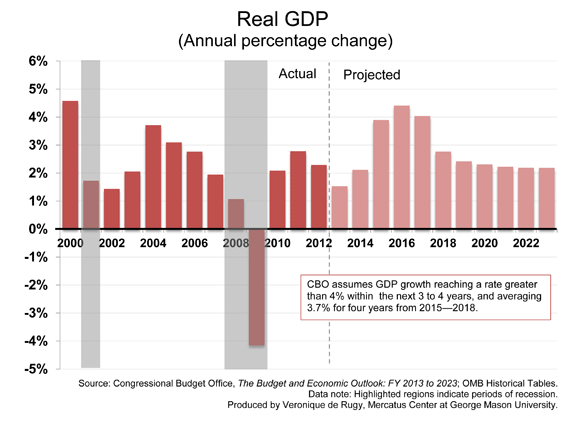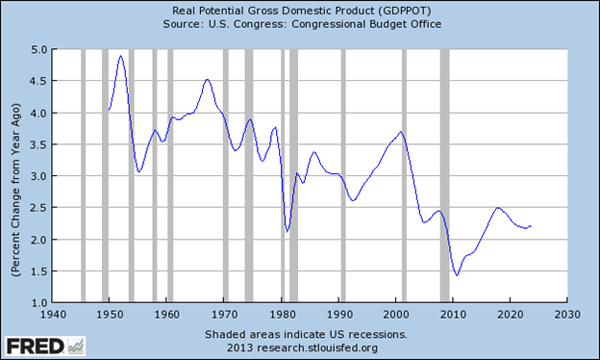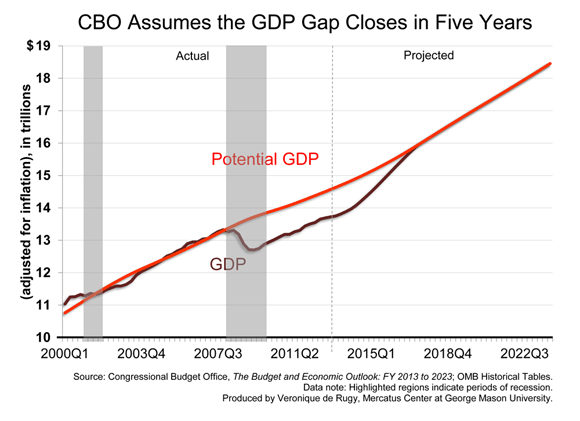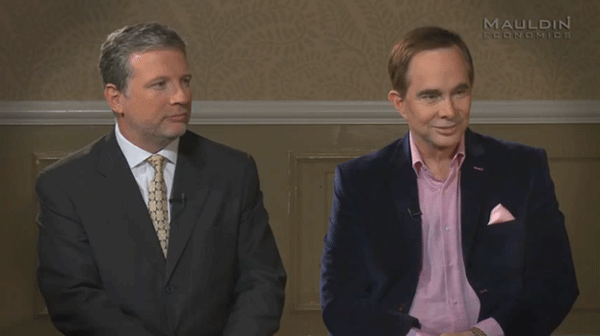
Assume a Perfect World
-
 John Mauldin
John Mauldin
- |
- April 13, 2013
- |
- Comments
- |
- View PDF
Assume a Perfect World
Objects in the Rear-View Mirror Are Larger
An Imaginary Recession
Peace in Our Time?
Government Spending Per Household Exceeds Median Household Income
What Do You Want It to Be?
Las Vegas, Singapore, San Francisco, and Carlsbad
An engineer, a chemist, and an economist are stranded on a deserted island. They are starving, when miraculously they find a box filled with canned food. What to do? They consider the problem, bringing their collective lifetimes of study and discipline to the task.
Being the practical, straightforward sort, the engineer suggests that they simply find a rock and hit the cans until they break open. “No, no!” cry the chemist and economist, “we would spill too much food and the birds would get it!”
After a bit of thought, the chemist recommends that they start a fire and heat the cans. The pressure in the cans will force them open and the food will conveniently already be heated. But the engineer and economist object, pointing out correctly that the cans would likely explode and splatter the food all over the beach.
The economist, after carefully studying the cans and reading the labels, starts scrawling a series of equations in the sand, which eventually cover the entire beach. After much pondering, he excitedly announces, “I’ve got it! I’ve got it!” as he points to the final equation. They ask him to explain, with their visions of finally getting a meal causing them to regard the economist with a new sense of respect.
The economist clears his throat and begins, “First, assume a can opener …”
I am not sure how old that joke is, but it dates to about the time when economists discovered mathematics and models, which is to say, about the time when economists developed physics envy and decided they would like to be regarded as scientists rather than philosophers. This week we continue to look at the data and models developed by economists, with a view to understanding both their usefulness and their limitations. The specific data we will examine this week is inspired by the release of the President’s FY 2014 US budget proposal this week. While it and the House and Senate budget proposals may appear to be widely divergent, there are some underlying and quite disturbing similarities among them.
Specifically, all three proposals assume away the real world. It does not matter which version you prefer; they all lack the basic precautions and hedges that those of us involved with preparing family and business budgets make sure to include in our own forecasts. While whole books could be written about the underlying assumptions in these latest budget proposals, we will examine (hopefully briefly) just a few of the more glaringly problematic ones.
Like our castaways with their abundance of canned food but no can opener, a US budget forecaster is faced with the problem of predicting the fiscal future of a very large, very real economic system, but without a crystal ball. And as we saw last week, economists are not particularly good at telling us what happened in the year that just passed, let alone in the year to come. (And we often see national budgets that presume to extend out for ten years or more.)
The basic challenge is pretty simple. There is a need to forecast revenues and expenses. Expenses are the more straightforward of the two. Most government expenses are line items in a budget. “We project we will spend $5 billion a year fixing roads and bridges, $1 billion on our national parks, $925 billion on defense, etc.” Social Security, too, is straightforward. Healthcare involves a lot of guestimates, and unemployment costs go up and down with the economy.
Revenues are a bit trickier. Income tax revenues obviously go up and down with incomes, as do corporate taxes and Social Security and Medicare taxes. If there is a recession, revenues will fall. If you get an economic boom, then revenues could turn out better than projected. I think I remember some economists predicting in the mid-’90s that the rest of the decade would be flat or trend down – we had a boom. In the middle of the last decade I predicted a Muddle Through Economy, which to me meant 2% GDP growth, down from the average of 3% we had experienced for decades. Two percent turns out to have been slightly optimistic, although I remember more than a few people telling me I was just too bearish. I would be very happy if we could manage 2% average growth for the current decade. As I wrote a few months ago (here and here), there are several respected forecasters, including Jeremy Grantham and Robert Gordon, who think 1% (or less!) is more likely.
Last year we were at a real inflation-adjusted growth rate of 1.7%. Nominal growth of 3.5% for 2012 was the lowest since the end of WWII. So what do our intrepid budget forecasters predict for the next ten years? Not content to project that current trends will persist, they have whipped on their rose-colored glasses to deliver us bright promises of spectacular growth.
David Malpass writes Thursday in the Wall Street Journal that Obama’s 2013 budget projections make a prediction of 3.6% growth by 2016, with tax revenues up by 50%. But Obama may seem to be conservative if we look at the projections of the Congressional Budget Office.
The next chart is from work done by Veronique de Rugy. It shows that the CBO projects that growth in 2013 will slow to 1.4% and then TRIPLE to 4.2% over the next three years! In the years 2015-2017 they project the US to grow 4% annually on average. And that is real growth they’re foreseeing, not nominal growth.

I read that and went straight to the latest CBO report to check. But there on page 40 and following were the actual numbers.
The next chart is from page 41 of that 77-page report, which contains extensive details as to how they arrive at their various expense and revenue projections. I should note that they are consistent in that they do not project low interest rates during their predicted economic boom of the next several years. The Obama administration, on the other hand, assumes in their budget proposal that interest rates will be only 1.2% in 2106, to accompany their 3.6% growth (and inflation of only 2.2%). Now THAT would be a very accommodative Federal Reserve.

Either way, interest costs are projected to rise dramatically as the decade progresses, more than doubling in real terms. In nominal terms, interest-rate costs are expected to increase almost FOURFOLD, from a current $224 billion to a projected $857 billion! That means interest-rate costs are projected to grow to roughly 16% of the federal budget within this decade (back-of-the-napkin estimate).
The increase in debt (in dollar terms), along with an anticipated substantial rise in interest rates as the economy strengthens, is expected to sharply boost interest payments on the debt. CBO projects that, under current law, the government’s yearly net interest spending will double as a share of GDP—from 1.5 percent in 2014 to 3.3 percent in 2023, a percentage that has been exceeded only once in the past 50 years. (CBO)
I should note that both the CBO’s and the Obama administration’s assumptions are much more optimistic than those of Federal Reserve economists (to the extent that they make projections). And the track record of the Fed is that, on average, they have projected 2.1% more GDP growth than actually occurred, just one year out.
Philippa Dunne & Doug Henwood of The Liscio Report supplied that surprising figure, and continued in their piece this week:
What does this mean for the future? Since the timing of the withdrawal of ease is highly dependent on these major economic indicators, we should take the Fed’s forecasts of their future course skeptically. Given the demonstrated difficulties they have forecasting a year or less ahead, forecasts two years or more in the future seem especially questionable. (Corroborating a remark from a CBO official we relayed back in 2007 that forecasting out even 2 years is a waste of time.) Since so many forecasts tend to be extrapolations of the present and recent past, the timing of QE withdrawal is likely to be more dependent on the real-time trajectory of major economic indicators than on imagined futures.
Even though at least one CBO economist thought it was a waste of time to make even two-year projections, they do attempt a ten-year projection. How optimistic are they? Well, let’s go the FRED database at the St. Louis Fed (a marvelous tool and one of the more important free sources I use).
Like what you're reading?
Get this free newsletter in your inbox every Saturday! Read our privacy policy here.
This is the percentage change in GDP year over year since 1940. Note that we have to go back to the 1960s to find a period where GDP grew by 4% for three years running. In fact, we have to go to 1969 to find even one year when it was 4%!

Objects in the Rear-View Mirror Are Larger …
Optimistic GDP projections mean that whatever revenue projections accompany them are also likely to be overly optimistic. Given the federal government’s lack of control over expenses, and its track record in forecasting expenses, it is likely that expenses will be underestimated, making actual deficits larger than they expect. One example: we have already seen Obamacare costs rise by over 40% from the projections just two years ago.
(That 40% does not even take into account what your private insurance costs have already risen and are going to continue to rise. Obamacare is going to be a giant economic debacle. That is not meant as an argument for or against universal coverage or coverage of pre-existing conditions. It is just noting that the economics of the way we are going about achieving our healthcare goals are turning our national program into a daunting fiscal disaster.)
Go back and look at the chart just above. Notice the shaded gray areas. Those are recessions. Now notice that there is not one decade without a recession, and most have two. Obama, the Senate, and the House all assume that we have vanquished the recession virus and will not experience that economic malady again in our near future.
Can I get any of my readers to make a wager with me that the US will somehow get through the rest of this decade without a recession? Buehler? Anyone? I thought not.
But that is exactly the wager that Congress and Obama are making with your tax dollars. Their budgets show expenses rising for the next ten years. And if we get a recession they will want to run even larger deficits. Their argument will be that we can’t possibly cut the fiscal deficit during a recession – that would make things even worse! Austerity doesn’t work; we all know that.
What happens if we do get a recession? Revenues go down, of course. Unemployment goes up, as do associated costs like unemployment checks.
Note the graph below. CBO forecasters assume that GDP will recover back to its former trend line, instead of simply growing from a lower base; and that is where they get their obscenely rosy back-to-back-to-back 4% increases.

What happens if we land in a recession instead? Not only do we not get back to that trend, we drift farther from it! Will the CBO then project 5% GDP growth for three years running to get us back to the original trend? That would be no more absurd than what they are doing now.
The reality is that no politician or government agency can forecast a recession (unless, as in 2012, they are arguing against a sequestration that is projected to actually cut spending). None of us really know when the next recession will happen. Theoretically, we could go another 10 years without one. It is also possible that the government will reveal that there really are aliens in Area 51. I leave it to you to decide which is more likely.
While acknowledging that forecasting a recession is impossible and politically a non-starter, it would be nice if forecasters and politicians were to admit the possibility of lower-than-estimated revenues and willingly contemplate what might happen if a recession did transpire. As the US approaches a truly debilitating debt level, I want to ask them, “Will you please tell us what the plan is if we experience recession rather than expansion?”
I can hear the answer now: “I don’t want to speculate about possible recessions. That is pointless.” But my rejoinder would be, “You are perfectly willing to speculate that we will have no recession and that we will grow at a rate not seen in over 40 years, not even during the Reagan and Clinton boom years. How speculative is that?” (Where is Nixon when we need him? Or was the growth during his reign a legacy from Kennedy and Johnson? Or was it just American productivity?)
Like what you're reading?
Get this free newsletter in your inbox every Saturday! Read our privacy policy here.
The defense budget is projected to fall about 13% in actual dollars from 2011 to 2014 and to fall as a percentage of GDP every year. The liberal Brookings Institution argues that Obama’s budget is unrealistic in that it cuts spending too much. (In Obama’s defense, he is not cutting entitlements very much and cuts everything else to preserve them as much as possible, which from his point of view is the correct policy choice.)
The president’s spending projections are even less realistic. Between 2013 and 2023, defense spending is projected to fall by 40 percent as a share of GDP, from 4.0 percent to 2.4 percent, while non-defense discretionary programs fall by one third, from 3.7 percent to 2.5 percent. This is barely imaginable, but highly unlikely. During the past half-century, defense spending has never gone below 3 percent of GDP, not even in the years between the fall of the Soviet Union and September 11, 2001. Non-defense spending has never gone below 3.2 percent, a level it reached near the end of the Clinton administration. (During the Reagan era, it never went below 3.5 percent.) It is hard to believe Obama’s proposals would allow us either to meet our basic security needs or to afford the level of public investments that have helped sustain economic growth throughout our national history. It’s up to senior administration officials to make the case that their numbers are realistic, and they’ll face a heavy burden of proof.
In short, even with substantial increases in revenues, the swelling pressure of entitlements and debt is leading our country to shortchange its future. Is that the course we want, or are we backing into it because we aren’t willing to challenge the assumptions that are producing it? Before we get mired in technicalities, that’s the threshold argument we should be having. (Brookings Institution)
Government Spending Per Household Exceeds Median Household Income
In fiscal 2010, according to numbers published by the Census Bureau and the Office of Management and Budget (OMB), net spending by all levels of government in the United States was $5,942,988,401,000. That equaled $50,074 for each one of the 118,682,000 households in the country.
In that same year, according to the Census Bureau, the median household income was $49,445. That means total net government spending per household ($50,074) exceeded median household income (49,445) by $629... As recently as 2000, the relationship between government spending and household income was dramatically different. Data from the Census Bureau and the OMB show that in that year net spending by all levels of government was 3,239,913,876,000. That equaled $29,941 for each of the nation’s then 108,209,000 households. In 2000, the median household income was $41,990... (A very interesting e-book called Completely Predictable)
The next oldest economist joke goes like this: A businessman interviews a mathematician, an accountant, and an economist for a job. He asks them, “What is 2 + 2 ?” The mathematician answers, “Exactly 4.” The accountant replies, “Depending on what your interest, depreciation, and taxes are, approximately 2.”
The economist walks over to the door, shuts and locks it, closes the blinds on the window, and leans over and softly asks, “What do you want it to be?”
Budget forecasts are a lot like that. A politician wants to enact a certain deficit-reduction policy. He wants to make assumptions that work to his benefit. So he calls in his friendly local economist, who obligingly responds, “You need 4% growth to make this work? No problem. Here’s the data and math to back up those assumptions.”
The CBO is supposed to be politically neutral. And it is: those 4% projections it came up with are good for both parties. If they projected a 2% real GDP growth for the next eight years, the agency would be disbanded. And gods forbid they pull a Jeremy Grantham or (Northwestern University professor) Robert Gordon and project 1%. Or a Bill Gross, at 1.5%. With those low growth expectations, the CBO’s projected budget deficits get blown sky-high, projected new expenditures seem just a tad extreme, and those tax cuts they’re talking about will be much more difficult to budget.
Government economists would like to assume a perfect world: no recessions; extraordinary, never-before-seen growth; peace, with no need to worry about nagging little military problems or defense; falling unemployment; rising tax revenues, when government spending is already taking a huge chunk out of the economy; interest rates staying under control; deficits falling over time; and on and on.
It's not easy being an economist. How would you like to go through life pretending you could predict the future and even knew what M1 was all about? It is absolutely necessary that we make forecasts as part of a responsible approach to government spending, but we need to be more skeptical of those forecasts and use some common sense in our budgets in order to allow for a rainy day here and there.
Liberal-socialist Sweden allows its pensions to rise and fall with GDP, so as to keep from blowing out their budget process. They made that hard choice in the midst of a credit crisis. Perhaps we too should make a hard choice now, in order to make sure we don’t have a major crisis of our own.
Waiting for our forecasts to be wrong before we adopt a yet another “solution” based on a temporary fix of yet another forecast that turned out to be wrong is no way to run a railroad, unless you want your train running off a cliff. I applaud the recent attempts in DC to come to a solution on the deficits and budget, but where are the leaders who want to get real with those forecasts?
Las Vegas, Singapore, San Francisco, and Carlsbad
I will be in Las Vegas as you read this, joining my doctor, Mike Roizen, at a fundraising event to benefit the Cleveland Clinic Lou Ruvo Center for Brain Health. The event will have Sir Michael Caine and Quincy Jones celebrating their 80th birthdays together. Born in the same year, same month, same hour, and within minutes of each other, their lives have touched multiple generations. Michael Caine is one of my favorite actors. (Dirty Rotten Scoundrels? And Secondhand Lions, with Robert Duvall, is a classic.) I have never done an event like this (with so many stars performing) where I will actually be close to the action. I have no business getting on another plane to stay at another hotel this week, but when will I ever get a chance like this again?
I get back Monday to pack for my trip to Singapore. I am told the conference, sponsored by Saxo Capital Markets and The Business Times, is sold out. I will get to be with old friends Grant Williams (You know him from Things That Make You Go Hmmm… and Bull’s Eye Investor), his partner Steve Diggle, and Simon Hunt, who is a go-to source on China. I hope to get to Malaysia with Grant for a side trip, just for fun, one of the days I am there.
As a quick aside, and apropos of our theme of distinguishing the real from the fake, I did a recent video conversation with Grant that I really want to show you. Our publisher, Ed D’Agostino, was there to ask us just the right questions, and we developed some themes that turned out to be a bit surprising, even to us. You can drop in on the conversation here.
Like what you're reading?
Get this free newsletter in your inbox every Saturday! Read our privacy policy here.
I leave Singapore Friday evening, only to stop in San Francisco to do a speech on Monday for the National Association of Surety Bond Producers annual meeting, before heading back home to rest up.
The next week I go to Carlsbad for my 10th annual Strategic Investment Conference (ably run and co-hosted by my partners at Altegris Investments), May 1-3. We have been doing a lot of planning for this one and have worked hard to make sure there will be a lot of interaction among the speakers on the stage and with the attendees. We managed to free up a few more spots this past week, so if you haven’t registered, this may be your last chance. It WILL sell out. To see the lineup that I think will make this the best investment conference this year, go to http://www.altegris.com/sic .
I have spent time recently on the phone or face to face with most of our speakers (I was with Nouriel on Wednesday). David Rosenberg has a completely new presentation and theme for this conference. Kyle Bass and Louis Gave will offer up ways to play Japan. Interest rates? Why not hear from the guys who have been right for decades? Managers who run billions and have done so successfully, across the entire gamut of market environments. Have questions about QE in the global environment? (Forget whether QE was right or wrong: what will they do about it now?) France? Italy? England? China? We’ll cover all that and much more.
I am making progress on getting the new apartment squared away. The home owners association of the building approved the plans today, so now we turn to the bankers to get the deal actually papered. It is time-consuming but rather fun. I have never designed a place for me before, but rather just took what was there. Getting the “new media” features right is a priority for my kids, and we are all excited about that. Blending the old and the new is a talent I am trying to cultivate. I am in a hotel only a few blocks from the high-rise where I will move later this year when construction is complete (late 3rd quarter?). I walked by it tonight while thinking about this letter. I think the energy of seeing the downtown Dallas lights will be helpful in the creative process. And I will have my writing desk and chair where I am a lot more comfortable, with a great gym a short elevator ride below.
It is late and I need to hit the send button. Harking back to our story about the economist and the can opener, I can’t just assume sleep. And I have to actually get some before I get on that plane. Have a great week.
Your wanting to move in already analyst,

John Mauldin
P.S. If you like my letters, you'll love reading Over My Shoulder with serious economic analysis from my global network, at a surprisingly affordable price. Click here to learn more.
Put Mauldin Economics to work in your portfolio. Your financial journey is unique, and so are your needs. That's why we suggest the following options to suit your preferences:
-
John’s curated thoughts: John Mauldin and editor Patrick Watson share the best research notes and reports of the week, along with a summary of key takeaways. In a world awash with information, John and Patrick help you find the most important insights of the week, from our network of economists and analysts. Read by over 7,500 members. See the full details here.
-
Income investing: Grow your income portfolio with our dividend investing research service, Yield Shark. Dividend analyst Kelly Green guides readers to income investments with clear suggestions and a portfolio of steady dividend payers. Click here to learn more about Yield Shark.
-
Invest in longevity: Transformative Age delivers proven ways to extend your healthy lifespan, and helps you invest in the world’s most cutting-edge health and biotech companies. See more here.
-
Macro investing: Our flagship investment research service is led by Mauldin Economics partner Ed D’Agostino. His thematic approach to investing gives you a portfolio that will benefit from the economy’s most exciting trends—before they are well known. Go here to learn more about Macro Advantage.
Read important disclosures here.
YOUR USE OF THESE MATERIALS IS SUBJECT TO THE TERMS OF THESE DISCLOSURES.
Tags
Did someone forward this article to you?
Click here to get Thoughts from the Frontline in your inbox every Saturday.

 John Mauldin
John Mauldin

